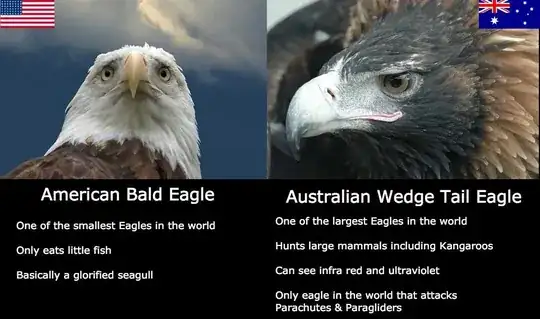American Bald Eagle - Haliaeetus leucocephalus
Claim #1: One of the smallest Eagles in the world.
False
Length of the American Bald Eagle is 94-106 cm (this is in the length range of 85 - 106 cm for Aquila audax) and wingspan is 5.9-7.5 ft (1.8-2.3 metres).
Weight is approximately 6.5 to 14 lbs (3 kg to 6.5 kg) which is more than the weight of Aquila audax which ranges between 2 kg to 5.3 kg.
The size range of the adult Bald Eagle is a wingspan of 168-244 cm, and body masses range from 3.0-6.3 kg (Buehler, 2000).
Second in size only to California condors (Gymnogyps californianus) and about the same size as golden eagles (Aquila chrysaetos), bald eagles dwarf most other North American raptors.
Based on information from data in 'Raptors of the World' by Ferguson-Lees, J and Christie D, 2001 present here, the size dimensions of American Bald Eagle when compared with eagles from other parts of the world is within the range of the heaviest eagles of the world, longest eagles of the world and eagles with the largest wingspan.
Claim #2: Only eats little fish.
Partly False
American bald eagles are known to prefer fish but they also scavenge carrion or steal the kills of other animals.
They also take birds, especially waterfowl, and occasional mammals.
In addition to eating other animals such as ducks, muskrats, and sometimes turtles, they eat carrion willingly, and are notorious for robbing osprey of their catches.
They are also reported to feed on human flesh and consume Harbor Seal placenta.
Claim #3: Basically a glorified seagull.
Debatable
Bald eagles are shown to hunt seagulls.
Australian Wedge Tail Eagle - Aquila audax
Claim #1: One of the largest Eagles in the world.
True
The Wedge-Tailed Eagle is known to be the largest raptor in Australia and fourth largest among the 10 largest eagles of the world based on the data in 'Raptors of the World' by Ferguson-Lees, J and Christie, D in 2001. The largest wingspan ever verified for an eagle was for this species when a female killed in Tasmania in 1931 was found to have a wingspan of 284 cm (9 ft 4 in) and another female measured barely smaller at 279 cm (9 ft 2 in).
Size - Length: 85 - 106 cm or 1.06 m (3 ft 6 in), Wingspan: 182 - 232 cm or 2.27 m (7 ft 5 in), Male weight: 2 - 4 kg, Female weight: 3.1 - 5.3 kg.
This eagle's great length and wingspan place it among the largest eagles in the world but its wings, at more than 65 cm (26 in), and tail, at 45 cm (18 in), are both unusually elongated for its body weight and 8-9 other eagle species regularly outweigh it.
In comparison, the wingspan of Steller's sea eagle (Haliaeetus pelagicus) is one of the largest of any living eagle in the world, at an median of 2.13 m (7 ft 0 in) and its weight is 5 to 9 kg (11 to 20 lb) which makes Aquila audax smaller in overall size (including body mass).
Claim #2: Hunts large mammals including Kangaroos
True
The Australian wedge tailed eagle is known to cooperatively hunt mammals such as adult kangaroos and kangaroo joeys which are baby kangaroos, birds such as emu and reptiles such as bobtail skinks.
You would expect such a huge, powerful bird to be a ferocious hunter. In fact, the Wedge-tailed Eagle is not nearly as swift or as deadly as other birds of prey such as falcons and sparrow hawks. Often it will swoop down onto a fleeing rabbit or wallaby, only to come up empty- handed (or empty-clawed!).
Wedge-tailed Eagles eat a wide variety of mammals, lizards and birds, depending on their local abundance. Mammals make up the greatest share of their diet, and rabbits are the most important live prey taken. They will also eat possums, gliders, cats, dogs, piglets, kangaroos, wallabies, lambs, goats, calves and foxes.
Simon Cherriman who has done extensive research on Wedgies has a lot of pictures of Australian Wedge Tail Eagle prey here.
Claim #3: Can see infra red and ultraviolet
Ultraviolet vision
True
Many bird species including other eagle groups and pigeons can see UV light.
Infra red vision
False
The majority of animals and birds are not sensitive to near-infrared spectrum (720nm-1500nm) based on this answer. Infrared detection in vertebrates is known in snakes and vampire bats.
Claim #4: Only eagle in the world that attacks Parachutes and Paragliders
Partly true but debatable
The known documented event was an attack of pair of wedge tailed eagles on a paraglider named Nicky Moss.
However, other eagle species such as the Himalayan golden eagles are also known to attack paragliders which is documented here and here.
